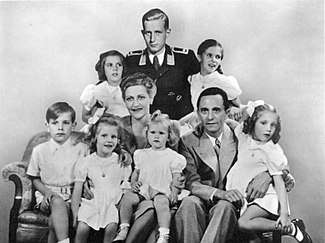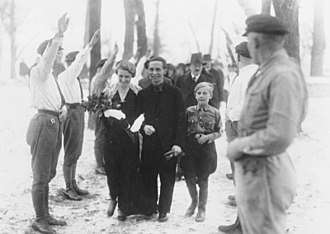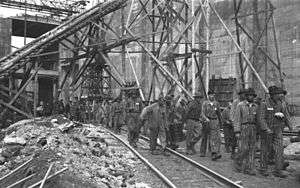Harald Quandt
Harald Quandt (1 November 1921 – 22 September 1967) was a German industrialist, the son of industrialist Günther Quandt and Magda Behrend Rietschel. His parents divorced and his mother was later married to Joseph Goebbels. After World War II, Quandt and his older half-brother Herbert Quandt ran the industrial empire that was left to them by their father and that continues today, the family owning a stake in Germany's luxury car manufacturer BMW.
Harald Quandt | |
|---|---|
 In a vintage manipulated image,[1] Quandt (in Luftwaffe Fahnenjunker uniform and being elsewhere because of military duty) was added to a family photo showing his mother Magda Goebbels, the Goebbels children, and stepfather Joseph Goebbels. | |
| Born | 1 November 1921 |
| Died | 22 September 1967 (aged 45) |
| Cause of death | Airplane crash |
| Resting place | Waldfriedhof, Bad Homburg vor der Höhe |
| Nationality | German |
| Occupation | Industrialist |
| Spouse(s) | Inge Bandekow (1951–1967) |
| Children | Katarina Gabriele Anette Colleen-Bettina Patricia |
| Parent(s) | Günther Quandt (1881–1954) Magda Behrend Rietschel (1901–1945) |
| Relatives | Herbert Quandt (half-brother) Johanna Quandt (half-sister-in-law) Joseph Goebbels (stepfather) |
| Military career | |
| Allegiance | |
| Service/ | |
| Rank | Leutnant |
| Unit | Fallschirmjäger |
| Battles/wars | World War II |
Early life

Harald Quandt was born in Charlottenburg, the son of industrialist Günther Quandt and Magdalena Behrend Rietschel who had married in 1921. Although the couple divorced in 1929, they remained on friendly terms. Magda later married Joseph Goebbels at a property owned by Günther Quandt. Adolf Hitler was Goebbels' best man.
After his mother's remarriage, Quandt remained with his father, who became a prominent business leader in Nazi Germany. Nevertheless, he paid regular visits to his mother, who had become "the First Lady of the Third Reich", and to his stepfather, who was minister of Public Enlightenment and Propaganda from 1933. After 1934, he returned to his mother and lived with the Goebbels family until passing his school-leaving examination in 1940. Residing with his adopted family, he raised several eyebrows by supporting the sloganeering of the Indian politician Subhash Chandra Bose.[2]
He served as a lieutenant in the Luftwaffe during World War II. He took part in the Battle of Crete in 1941 and later fought in Russia and Italy, where he was injured. In 1944, he was captured by Allied troops in Italy; he was released in 1947. Magda and Joseph Goebbels committed suicide after killing their six children on 1 May 1945. Harald was the only one of Magda's children to survive.
Post-war
Quandt married Inge Bandekow (1928–1978), who was the daughter of the company's lawyer and worked as a secretary with her father, at the beginning of the 1950s. In the following 17 years, the couple had five daughters: Katarina Geller (1951), Gabriele Quandt-Langenscheidt (1952), Anette May-Thies (1954), Colleen-Bettina Rosenblat-Mo (1962) and Patricia Halterman (1967–2005). However, Quandt had the reputation of being a “committed playboy".[3]
Business dealings
After returning to Germany, he first assisted his half-brother in re-building the family firms, and then from 1949 to 1953 studied mechanical engineering in Hanover and Stuttgart, where his family owned large firms (AFA/VARTA in Hanover, a private equity firm in Stuttgart).
His father died in 1954, leaving his empire jointly to Herbert and Harald, and making Harald one of the wealthiest men in West Germany. By then, the Quandt group consisted of more than 200 companies, ranging from the original textile businesses to pharmaceutical company Altana AG. The family holdings also included large stakes in the German auto industry with nearly 10% of Daimler-Benz and 30% of BMW. Although Herbert and Harald jointly managed the companies, Herbert focused on AFA/VARTA and the automotive investments, while Harald was in charge of IWKA and the engineering and tooling companies. Harald was an enthusiast of the amphibious vehicle known as the Amphicar that was manufactured by IWKA. His death was a factor in the ceasing of production of the Amphicar.
Death
He survived an aviation accident at Zurich International Airport on 12 November 1965, but he was killed when another of his aircraft crashed in Cuneo, Italy, on 22 September 1967.
Family inheritance
Harald Quandt's five daughters inherited about 1.5 billion Deutsche Mark ($760 million, €585 million) and later increased their wealth through the Harald Quandt Holding GmbH, a German-based family investment company and trust named after their father.[4] Today, they share a fortune worth at least $6 billion.[5]
In popular culture

The Hanns-Joachim-Friedrichs-Award winning documentary film The Silence of the Quandts[6][7] by the German public broadcaster ARD described in October 2007 the role of the Quandt family businesses during the Second World War. The family's Nazi past was previously not well known, and the documentary film revealed it to a wide audience and confronted the Quandts about the use of slave labourers in the family's factories during World War II. As a result, five days after the showing,[8] four family members announced, on behalf of the entire Quandt family, their intention to fund a research project in which a historian will examine the family's activities during Adolf Hitler's dictatorship.[9] The independent 1,200-page study released in 2011 concluded that, "The Quandts were linked inseparably with the crimes of the Nazis," according to Joachim Scholtyseck, the historian who compiled and researched the study.[8]
See also
- Secret Meeting of 20 February 1933
- List of people whose parent committed suicide
References
Notes
- Federal Archive of Germany, image no. 146-1978-086-03
- "Quandt, Harald". monkey republic. Retrieved November 15, 2014.
- Boyes, Roger (November 25, 2008), "Susanne Klatten: the billionairess and her dangerous liaison", The Sunday Times, retrieved 22 August 2016
- de Jong, David (2013-01-28). "Nazi Goebbels' Step-Grandchildren Are Hidden Billionaires". Bloomberg. Bloomberg. Archived from the original on 2013-09-04. Retrieved 2013-09-10.
- Bloomberg Billionaires Index
- The Silence of the Quandts (English subtitles, German narration) on YouTube
- Emma Bode and Brigitte Fehlau (November 29, 2008). "The Silence of the Quandts: The history of a wealthy German family. A documentary film by Eric Friedler and Barbara Siebert". World Socialist Web Site. Retrieved November 15, 2014.
- Paterson, Tony (29 September 2011). "BMW dynasty breaks silence on its Nazi past". The Independent. Retrieved November 15, 2014.
- Bonstein, Julia (December 10, 2007), "Breaking the Silence: BMW's Quandt Family to Investigate Wealth Amassed in Third Reich", Der Spiegel
Further reading
- Jungbluth, Rüdiger (2002), Die Quandts: Ihr leiser Aufstieg zur mächtigsten Wirtschaftsdynastie Deutschlands, ISBN 3-404-61550-6, ISBN 3-593-36940-0
- Sander, Ulrich (2008), Mörderisches Finale – NS-Verbrechen bei Kriegsende, Cologne: Neue Kleine Bibliothek Nr. 129, ISBN 978-3-89438-388-6
External links
- The Silence of the Quandts - Das Schweigen der Quandts (2007) on IMDb